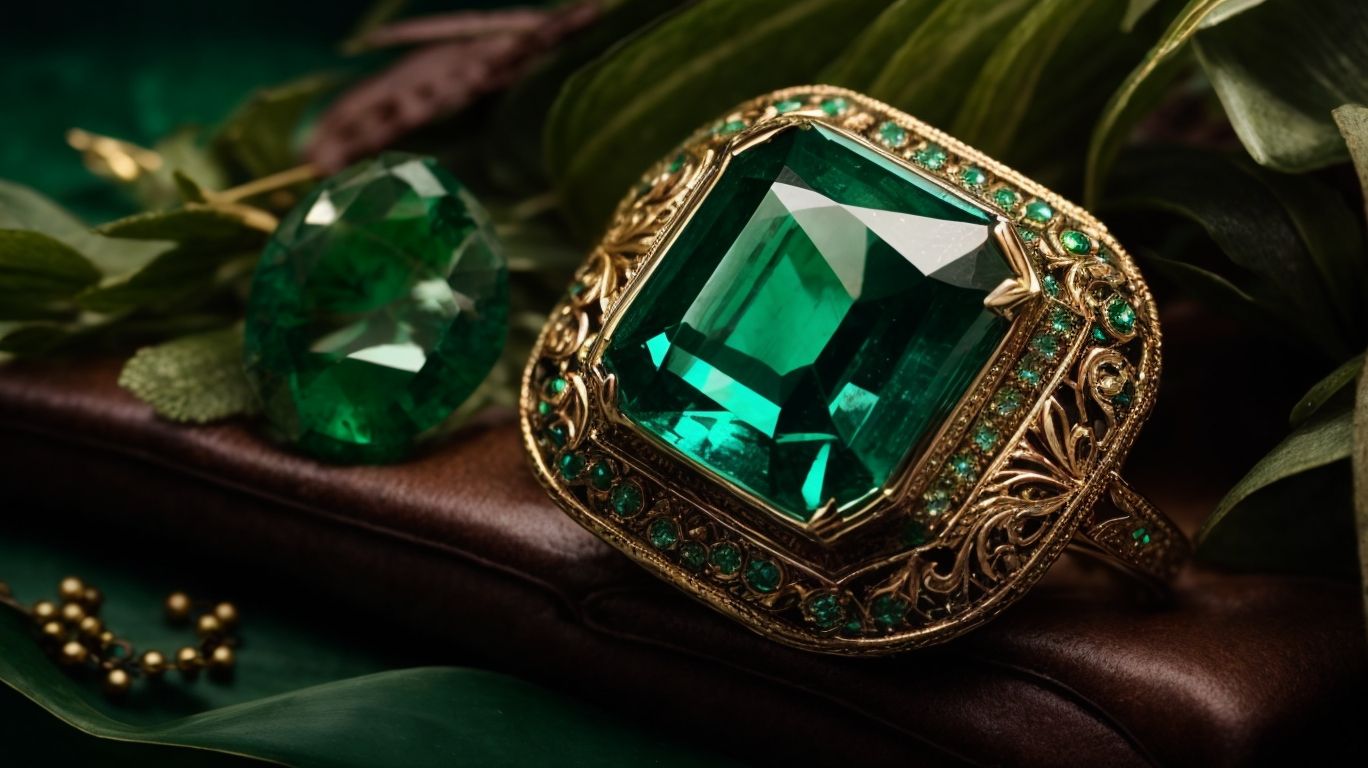
Emerald Meanings: Uncovering the Secrets of the Green Marvel
Emeralds have long been revered for their stunning beauty and mystical qualities. From ancient civilizations to modern times, emeralds have played a significant role in human history.
We delve into the history, symbolism, physical properties, mining process, and common myths surrounding emeralds.
Join us as we uncover the secrets of this green marvel and discover why emeralds have captured the hearts of countless people throughout the ages.
What are Emeralds?
Emeralds, known for their stunning green hue, are a marvel of the gemstone world with deep meanings and secrets embedded in their vibrant color.
This captivating gemstone has been revered for centuries not only for its beauty but also for the rich symbolism it holds. The color green, often associated with nature, growth, and renewal, is reflective of the emerald’s significance as a stone of love and rebirth. In ancient folklore, emeralds were believed to bring foresight, good fortune, and youthfulness to their wearers. Today, they continue to be valued for their rarity and brilliance, adorning royal crowns, engagement rings, and other exquisite jewelry pieces with their timeless elegance.
The History of Emeralds
The history of emeralds dates back to ancient civilizations such as the Egyptians and was revered by prominent figures like Aristotle and Cleopatra, symbolizing elements of Venus and Mercury with its earthy composition.
Cleopatra, known for her love of emeralds, believed that these captivating gemstones represented fertility and rebirth. The luminous green hue of emeralds, often associated with nature and growth, captivated the imagination of many ancient societies.
Their transparency, or lack thereof, coupled with unique inclusions, adds to their allure, making each emerald a distinct piece of natural art. The clarity and cut of emeralds play a crucial role in revealing their intense color and brilliance, with carat weight determining their value in the world of gemstones.
Ancient Civilizations and Emeralds
Emeralds held profound significance in ancient civilizations like the Egyptians, where they were believed to embody spiritual protection and symbolize divine connections, intertwining with myths, legends, and folklore.
These mesmerizing green gemstones were considered a representation of eternal youth and fertility in Egyptian culture. The pharaohs adorned themselves with emerald jewelry to invoke rebirth and vitality. It was believed that emeralds possessed the power to ward off evil spirits and bring prosperity to the wearer.
In myths, emeralds were often associated with the goddess Isis, symbolizing her connection to nature and healing. The color green was also linked to the cycle of life and the rejuvenating powers of the Nile River, making emeralds highly revered in the ancient Egyptian belief system.
Emeralds in Medieval Times
During medieval times, emeralds were revered for their mystical properties, embedded in the beliefs, cultures, and traditions of various societies, with intriguing histories of discovery and mining.
Emeralds were often associated with protection and healing powers in medieval times. In different cultures, these precious gemstones symbolized fertility, rebirth, and eternal youth. The color green was linked to nature and life, making emeralds even more significant.
From Byzantine to Mughal empires, emeralds adorned the crowns of rulers and leaders, signifying power and wealth. The mining of emeralds during that era was a demanding process, often requiring intense labor in treacherous conditions. Despite these challenges, the allure of emeralds endured, captivating minds and hearts across civilizations.
Emeralds in Modern Times
In modern times, emeralds continue to captivate with their timeless allure, influencing contemporary fashion trends, designs, and settings in precious metals like gold, silver, and platinum.
The rich green hue of emeralds adds a touch of elegance and sophistication to any outfit, making them a popular choice for both casual and formal occasions. Jewelry designers often incorporate emeralds into their collections to create eye-catching pieces that exude luxury and style. The versatility of emeralds allows them to be paired with a variety of gemstones, such as diamonds or sapphires, to create stunning and unique jewelry designs. Their significance in the realm of contemporary aesthetics lies in their ability to effortlessly elevate any look, making them a coveted gemstone in the world of fashion and jewelry.
The Symbolism of Emeralds
Emeralds symbolize more than just a stunning color; they represent spiritual protection, love, compassion, growth, harmony, and balance in various cultures and belief systems.
Throughout history, emeralds have been revered for their spiritual significance, believed to ward off negative energies and bring about inner peace. In addition to their protective qualities, emeralds are associated with healing emotional wounds and encouraging personal growth. It is said that wearing or meditating with emeralds can help cultivate a sense of harmony and balance, fostering a deeper connection with oneself and others. The deep green hue of emeralds has long been linked to themes of renewal and vitality, making them not only a beautiful adornment but also a symbol of transformation and rejuvenation.
Love and Relationships
Emeralds have long been linked to matters of the heart, symbolizing deep love, compassion, and emotional connections, making them ideal gifts for expressing heartfelt sentiments.
Their verdant hues are often associated with nature and growth, mirroring the nurturing essence of love and relationships. When gifted, emeralds carry a profound message of devotion and understanding, making them popular choices for engagement rings and anniversary presents. The allure of emeralds lies not only in their striking beauty but also in the belief that they can enhance the bond between partners, creating a lasting symbol of enduring love and commitment.
Wealth and Success
Emeralds are often seen as symbols of wealth, luck, and abundance, believed to attract prosperity and success to those who wear or possess these precious gemstones.
Throughout history, emeralds have been associated with financial well-being and good fortune, with some cultures even believing that these green gems have the power to enhance one’s financial status. It is said that emeralds bring about harmony in one’s life and help in manifesting desires related to wealth and success. This belief in the mystical properties of emeralds has led to them being cherished not just for their beauty, but also for their perceived ability to bring abundance and prosperity to individuals.
Healing and Protection
Emeralds are revered for their healing properties and protective energies, often associated with balancing the chakras and promoting physical, emotional, and spiritual well-being.
These magnificent gemstones are believed to emit a powerful energy that can help stimulate a connection between the physical and spiritual realms. By encouraging a harmonious flow of energy throughout the body, emeralds are thought to aid in resolving any blockages or imbalances in the chakras, leading to a sense of alignment and tranquility. Many individuals also turn to emeralds for their ability to foster emotional healing, facilitating a deep sense of compassion and understanding towards oneself and others. Wearing or meditating with emeralds is said to promote mental clarity and enhance creativity, making them valuable allies in achieving personal growth and self-discovery.
The Physical Properties of Emeralds
The physical properties of emeralds encompass their vivid green color, clarity levels, hardness, durability, cut styles, carat weight, and size variations, defining their unique appearance and value.
Emeralds are known for their mesmerizing green hue, ranging from a deep forest green to a light, almost translucent green. The clarity grades of emeralds can vary from highly transparent to slightly included, with the most valuable ones being almost free of imperfections.
In terms of hardness, emeralds rank at 7.5-8 on the Mohs scale, making them durable but also slightly more prone to damage compared to diamonds. The durability factor is crucial for determining how well an emerald can withstand everyday wear and tear.
When it comes to cut styles, emeralds can be faceted into various shapes like oval, pear, round, and emerald-cut, each presenting a different facet arrangement that affects their brilliance and overall appeal.”
Color and Clarity
The color and clarity of emeralds play a pivotal role in determining their value and allure, with these gemstones prized for their rich green hue and unique transparent properties despite natural inclusions.
Emeralds are known for their vibrant green color, which ranges from a deep lush forest green to a lighter, more vivid hue. This color variation can be attributed to the presence of chromium and vanadium in the gemstone’s composition. The transparency of an emerald is linked to its clarity, with higher-quality emeralds exhibiting minimal inclusions, enhancing their brilliance. Some collectors appreciate natural inclusions in emeralds as they are a testament to the gem’s authenticity and natural formation process, adding a distinctive character to each stone.
Hardness and Durability
Emeralds are known for their moderate hardness and durability, making them suitable for jewelry despite being a crystalline stone, with the cut style playing a crucial role in enhancing their longevity.
Their hardness level typically ranges between 7.5 to 8 on the Mohs scale, indicating relatively high durability. Due to their crystalline structure, emeralds are considered moderately hard, making them less prone to scratches compared to softer gemstones. Their durability is not indestructible, and proper care is necessary to prevent chipping or breaking. Skilled gem cutters employ precise techniques to maximize the stone’s beauty and strength, ensuring that the emerald retains its luster and brilliance over time in jewelry settings.
Size and Cut
The size and cut of emeralds influence their aesthetic appeal and fashion trends, with carat weight, faceting styles, and innovative settings playing a crucial role in showcasing their beauty and brilliance.
The carat weight of an emerald affects its perceived value and uniqueness, where a larger stone typically commands more attention. Meanwhile, the cutting style of the gemstone, whether it be traditional or modern, can enhance its overall brightness and sparkle. The setting design in which the emerald is expertly placed can add a touch of personalization and sophistication, elevating its allure to make a stylish statement for any occasion.
How are Emeralds Mined and Produced?
The process of mining and producing emeralds involves intricate techniques for extraction, followed by expert cutting, polishing, treatments, and enhancements to bring out their natural beauty and luster.
The extraction of emeralds typically begins with locating deposits in mineral-rich areas, often involving specialized machinery and tools to carefully extract the gemstones from the earth. Once extracted, the rough emeralds undergo a meticulous process of cutting, where skilled artisans shape the stones into the desired facets to maximize their brilliance. Polishing is then carried out to smoothen the surfaces and enhance the gem’s shine. Treatments such as oiling or resin infusions are commonly used to improve the clarity and color of emeralds, while enhancements like laser drilling may be applied to minimize imperfections and enhance their overall quality for use in various jewelry designs.
Mining Techniques
Emerald mining involves specialized techniques that vary by region, with countries like Colombia, Zambia, and Brazil being renowned for their rich emerald deposits and distinctive mining methods.
- In Colombia, traditional mining methods often involve artisanal miners working in narrow tunnels, using hand tools to extract emeralds from the rock. These miners rely on their experience and skill to navigate the challenging terrain.
- In contrast, Zambia has seen modernization in its mining practices, with companies employing advanced machinery and technology to extract emeralds from the underground mines more efficiently.
- Brazil, known for its open-pit mining operations, involves large-scale machinery and equipment to extract emeralds from the ground, creating vast mining landscapes.
Cutting and Polishing Process
The cutting and polishing of emeralds require precision and expertise to enhance their clarity, optimize the cut for maximum brilliance, and create intricate facets that showcase the gemstone’s beauty.
This meticulous process involves skilled artisans who meticulously examine each emerald for imperfections or inclusions that may affect its visual appeal. Clarity enhancement techniques such as filling cracks with oil or resin are often used to improve the gem’s transparency. The precision cutting techniques employed ensure that the emerald is shaped and sized to perfection, allowing light to refract through its surface and exhibit a captivating play of color. By carefully crafting facets on the emerald’s surface, the gem’s natural allure is accentuated, resulting in a stunning and mesmerizing gemstone.
Treatments and Enhancements
Emeralds may undergo treatments and enhancements to improve their appearance, with synthetic and natural methods utilized to enhance color, clarity, and overall quality of these precious gemstones.
These treatments, sometimes known as enhancements, play a significant role in the gemstone industry by offering ways to enrich the natural beauty of emeralds. Common enhancement methods can include oiling, dyeing, resin filling, and fracture filling to minimize imperfections and bring out the desired shades of green. It is essential for consumers to be aware of these treatments to make informed decisions when purchasing emeralds. While natural emeralds are highly coveted for their rarity, treated emeralds can also exhibit stunning colors and sparkle that appeal to a wider market.
Common Myths and Misconceptions about Emeralds
Despite their allure, emeralds are surrounded by common myths and misconceptions, such as assumptions about their always being green, universally high prices, and misconceptions regarding their durability.
It is important to debunk these misconceptions and shed light on the truth about emeralds. One prevalent myth is that emeralds must always be green. In reality, emeralds can come in various shades of green, from light and vibrant to deep and rich hues. While emeralds are often associated with luxury and high prices, there are affordable options available in the market.
Another misconception is that emeralds are fragile gemstones, but when properly cared for, they can be durable and long-lasting.
Emeralds are Always Green
One common myth about emeralds is the belief that they are always green, perpetuated by myths, legends, and folktales that ascribe a singular color identity to these diverse gemstones.
In ancient cultures, emeralds were often associated with various gods and goddesses, leading to the misconception that these gems could only exist in shades of green. Stories of emerald mines guarded by mystical creatures or hidden in enchanted forests further fueled the idea that their color range was limited.
It was not until gemologists expanded their research and exploration that the true spectrum of emerald hues – including shades of yellow, blue, and even red – began to be appreciated and understood, debunking the long-standing myth of their exclusively green nature.
All Emeralds are Expensive
The notion that all emeralds are prohibitively expensive is a common misconception rooted in beliefs, cultures, traditions, superstitions, and folk legends that have elevated the perceived value of these gemstones.
Across various societies and historical periods, emeralds have held significance beyond their monetary value. In many cultures, emeralds are associated with attributes such as love, hope, and renewal, imbuing them with symbolic importance. For centuries, these vibrant green gems have been cherished for their beauty and believed to possess mystical powers that bring good fortune and protect against evil. These cultural narratives have contributed to the mystique surrounding emeralds, reinforcing the idea that they are precious beyond measure.
Emeralds are Brittle and Fragile
Emeralds being considered brittle and fragile is a misconception regarding their durability and strength, often misunderstood due to the gemstone’s crystalline nature and perceived vulnerabilities.
Contrary to popular belief, emeralds are not as delicate as commonly thought. While it is true that they may have natural inclusions or internal fractures due to their formation process, these features do not necessarily make them weak or prone to damage. In fact, when cut and cared for properly, emeralds can exhibit remarkable toughness and resilience, making them suitable for everyday wear. The key lies in understanding and respecting the gemstone’s unique characteristics and taking appropriate measures to ensure their longevity and beauty.




No Comments